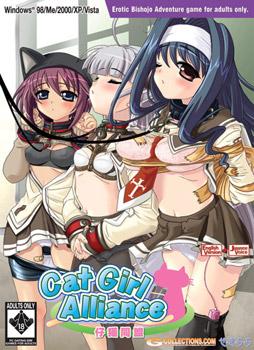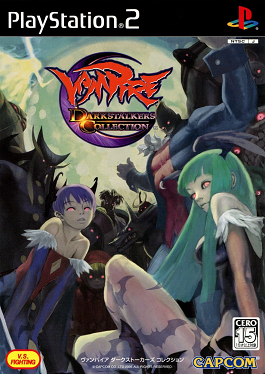
In video gaming, a fan translation is an unofficial translation of a video game made by fans.

Drakengard, known in Japan as Drag-On Dragoon, is a 2003 action role-playing video game developed by Cavia and published by Square Enix for the PlayStation 2. The game is the first installment of the Drakengard series and features a mixture of ground-based hack-and-slash, aerial combat, and role-playing elements which have become a staple of the series. The story is set during a religious war between two factions—the Union and the Empire—with the war tipping in favor of the Empire. The player controls Caim, a deposed prince of the Union, in his quest for vengeance against the Empire. Wounded in battle while protecting his sister Furiae, he is forced to make a pact with a red dragon named Angelus as they journey together on a quest to prevent the Empire from destroying magical seals that keep the world in balance.

The Sailor Moon musicals, commonly referred to as Sera Myu, are a series of live theatre productions based on the Sailor Moon manga by Naoko Takeuchi. The series consists of 40 musicals which have had more than 800 performances since the show opened in the summer of 1993. The first set of musicals, which ran from 1993 to 2005, were produced by Bandai with over 500 performances. The current musicals have been produced by Nelke Planning since 2013.

Breath of Fire is a role-playing video game developed by Capcom originally for the Super Nintendo Entertainment System. Initially released in Japan in April 1993, the game was later made available in North America in August 1994 by Square Soft, who handled the title's English localization and promotion. It is the first entry in the Breath of Fire series.
Makoto Kawada, known by the pen name Makoto Raiku, is a manga artist known for creating the Zatch Bell! franchise. Starting off an assistant for Kazuhiro Fujita on his manga Ushio & Tora, he began creating several one-shots for the Weekly Shōnen Sunday shōnen manga anthology such as Bird Man, Hero Ba-Ban and Genmai Blade. By 1999, he had created the series Newtown Heroes, which was published in Shōnen Sunday Super, a seasonal publication featuring upcoming manga artists and one-shots from the main Sunday book.

Mobile Suit Gundam Unicorn is a novel by popular Japanese author Harutoshi Fukui. The novel takes place in Gundam's Universal Century timeline. Character and mechanical designs are provided by Yoshikazu Yasuhiko and Hajime Katoki, respectively.

ZyX is a Japanese erotic bishōjo video game maker. Some of their products have been localized in North America by JAST USA under the G-Collections label, and most of them feature designs by either Masahiro Yamane or Keiji Muto.

Bishōjo Senshi Sailor Moon: Another Story is a role-playing video game developed and published by Angel exclusively for the Super Famicom in Japan on 22 September 1995. Based upon Naoko Takeuchi's Sailor Moon shōjo manga and anime series, the game takes place between the third season and fourth season of the anime series, which adapted the third and fourth arcs of the manga respectively, as players take control of either the five Inner Guardians or the four Outer Guardians in order to protect Crystal Tokyo by fighting against a group of rebels and several of their previously defeated enemies once again that were resurrected by the sorceress Apsu.

SD Sengokuden Musha Shichinin Shuu Hen is the first work in the long-running Musha Gundam series.

Kidou Senshi Gundam Seed: Rengou vs. Z.A.F.T. is a third person arcade game based on the Gundam Seed franchise. It was developed in 2005 by Capcom and published by Banpresto, Bandai, and Namco Bandai Games in Japan. Similarly to Mobile Suit Gundam: Gundam vs. Zeta Gundam, the player can choose to ally themselves with either O.M.N.I., Z.A.F.T. or Blue Cosmos and fight against the other factions. The Arcade Mode has 9 stages plus a bonus Extra Stage.

Queen's Blade is a Japanese series of visual combat books published by Hobby Japan inspired by the licensed works from Firelight Game Company's Lost Worlds. The overall plot of the game revolves around a tournament called the Queen's Blade, which is held once every four years to determine a Queen.

Koneko Doumei is a Japanese erotic visual novel developed by Sekilala and published by CD Bros., released on February 20, 2004 for Windows. It was localized in North America as Cat Girl Alliance by G-Collections on February 20, 2010.

Final Fantasy: The 4 Heroes of Light, known in Japan as Hikari no 4 Senshi -Final Fantasy Gaiden-, is a role-playing video game developed by Matrix Software and published by Square Enix for the Nintendo DS. It is a spin-off of the Final Fantasy series and was released by Square Enix in Japan in 2009. The game was released in North America and Europe in October 2010.

Final Fantasy Dimensions is a role-playing video game developed by Matrix Software and published by Square Enix for mobile devices. Similar to Final Fantasy IV: The After Years, it was initially released as an episodic game, with the first two installments released in September 2010 on the Japanese i-mode distribution service, and in December 2010 for the EZweb distribution service. The game was remade for the iOS and Android platforms and released internationally in August 2012.

Final Fantasy IV: The Complete Collection is a compilation consisting of enhanced ports of the role-playing video games Final Fantasy IV (1991) and Final Fantasy IV: The After Years (2008), as well as a new scenario called Final Fantasy IV Interlude, which is set between the two games. It was published by Square Enix for the PlayStation Portable in Japan on March 24, 2011, with other markets released in April. It was also released as digital download.

Vampire: Darkstalkers Collection is a compilation of all five Darkstalkers arcade games that were released in Japan only for the PlayStation 2 in 2005. Darkstalkers Collection was also released together with Hyper Street Fighter II: The Anniversary Edition as part of one of the Value Pack compilations for the PS2 in 2008 in Japan.

Lightning Warrior Raidy is a dungeon-crawling RPG Eroge developed by ZyX, and later translated to English by G-Collections.
Kinu Nishimura is a Japanese video game and anime concept artist and illustrator. Currently freelance, she is best known for her character design and promotional art for Capcom's fighting games during the 1990s.

Bishōjo Senshi Sailor Moon S: Jōgai Rantō!? Shuyaku Sōdatsusen is a 1994 fighting video game developed by Arc System Works and published by Angel for the Super Famicom. It is based upon Naoko Takeuchi's Sailor Moon manga and anime series and stars heroic teenage girls who represent the major celestial bodies of the solar system. The player takes control of one of the girls who have decided to stage a fighting tournament to determine who should lead the group.


















